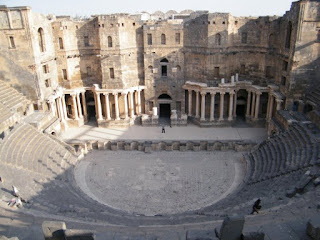The Nabateans were an ancient Semitic people of southern Jordan, Canaan and the northern part of Arabia. The Nabateans archaelogical sites are not a single site but a group of sites at Petra, Shivta, Avdat, Bosra and other places providing a glimpse of the ancient architecture making up for an exciting trip.
Petra
Established sometime around the 6th century BCE as the capital city of the Nabateans, it is a symbol of Jordan as well as its most visited tourism attraction. Petra was chosen by the BBC as one of "the 40 places you have to see before you die". Excavations have demonstrated that it was the ability of the Nabataeans to control the water supply that led to the rise of the desert city, creating an artificial Oasis. The area is visited by flash floods and archaeological evidence demonstrates the Nabataeans controlled these floods by the use of dams, cisterns and water conduits. These innovations stored water for prolonged periods of drought, and enabled the city to prosper from its sale. Some pointers to christanity are also available such as the 'Urn Tomb.
The Amphitheatre at Petra is also witness to what the culture had on offer then. Other wonders to see in Petra are El Deir (The Monastery) , The Hadrien Gate and the Sandstone caves. The Al Khazneh derives from one legend that bandits or pirates hid their loot in a stone urn high on the second level. Significant damage from bullets can be seen on the urn. Local lore attributes this to Bedouins, who are said to have shot at the urn in hopes of breaking it open and spilling out the "treasure" within (the decorative urn, however, is solid sandstone). Another is that it functioned as a treasury of the Egyptian Pharaoh of the time of Moses (Khaznet Far'oun
Bosra- is an ancient city administratively belonging to the Daraa Governorate in southern Syria. It is a major archaeological site and has been declared a UNESCO World heritage site. Today, Bosra is a major archaelogical site, containing ruins from Roman, Byazntine, and Muslim times, its main feature being the well preserved Roman theatre. Every year there is a national music festival hosted in the main theater.
Mada in saleh - The site constitutes the kingdom's southernmost and largest settlement after Petra, its capital. In 2008, for its well-preserved remains from late antiquity, especially the 131 rock-cut monumental tombs, with their elaborately ornamented façades, of the Nabatean kingdom, UNESCO proclaimed Mada'in Saleh as a site of patrimony, becoming Saudi Arabia's first World Heritage Site. According to the Islamic text, Allah punished the Thamudis for their persistent practice of idol worship and for conspiring to kill the Propeht whom he had sent, the non-believers being struck by an earthquake and lightning blasts. Thus, the site has earned a superstitious reputation down to contemporary times as a cursed place.
Places to See
Shivta - Another Archaelogical site from the Nabataen times, It is not under the army control. The Shivta site contains three Byzantine churches, 2 wine-press, residential areas and administrative buildings. After the Arab conquest in the 7th Century CE, Shivta began to decline in population. It was finally abandoned in the 8th or 9th Century CE.
Avdat- A smaller site with ruins relating to the Nabatean culture.
Wadi Rum- A major site of Nabatean Petroglyphs.
Directions, Accomodation and Duration
By Road: JETT buses connect to Amman and Aqaba via the Desert Highway. Other buses also come from Eilat. Tours to Petra from Taba, Sinai, Wadi Rum, Amman and Sharm el Sheikh are also gaining popularity with charter tourism.
Nearest airports are at Tel Aviv, Ammam and Eilat.
Accomodation: Guesthouses are available in Wadi Rum. Also various cheap motels and luxury resorts have come up around Petra.
Duration: The total trip including all the sites will require 7-10 days. The sites include various contries including Syria, Jordan and Iran so be prepared to arrange for prior visas where necessary.
* - http://en.wikipedia.org/wiki/Nabateans


 9:33 PM
9:33 PM
 Unknown
Unknown






0 comments:
Post a Comment